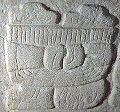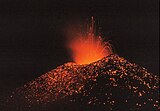The Central America Portal

Central America is a subregion of North America. Its political boundaries are defined as bordering Mexico to the north, Colombia to the southeast, the Caribbean to the east, and the Pacific Ocean to the southwest. Central America is usually defined as consisting of seven countries: Belize, Costa Rica, El Salvador, Guatemala, Honduras, Nicaragua, and Panama. Within Central America is the Mesoamerican biodiversity hotspot, which extends from southern Mexico to southeastern Panama. Due to the presence of several active geologic faults and the Central America Volcanic Arc, there is a high amount of seismic activity in the region, such as volcanic eruptions and earthquakes, which has resulted in death, injury, and property damage.
In the pre-Columbian era, Central America was inhabited by the Indigenous peoples of Mesoamerica to the north and west and the Isthmo-Colombian peoples to the south and east. Following the Spanish expedition of Christopher Columbus' voyages to the Americas, Spain began to colonize the Americas. From 1609 to 1821, the majority of Central American territories (except for what would become Belize and Panama, and including the modern Mexican state of Chiapas) were governed by the viceroyalty of New Spain from Mexico City as the Captaincy General of Guatemala. On 24 August 1821, Spanish Viceroy Juan de O'Donojú signed the Treaty of Córdoba, which established New Spain's independence from Spain. On 15 September 1821, the Act of Independence of Central America was enacted to announce Central America's separation from the Spanish Empire and provide for the establishment of a new Central American state. Some of New Spain's provinces in the Central American region (i.e. what would become Guatemala, Honduras, El Salvador, Nicaragua and Costa Rica) were annexed to the First Mexican Empire; however in 1823 they seceded from Mexico to form the Federal Republic of Central America until 1838. (Full article...)
Selected article
The Honduran white bat (Ectophylla alba), also called the Caribbean white tent-making bat, is a species of bat in the family Phyllostomatidae. It is the only member of the genus Ectophylla. The genus and the species were both scientifically described for the first time in 1892. It has distinctive, entirely white fur, which is only found in six of the roughly 1,300 known species of bat. It constructs "tents" out of understory plant leaves by strategically cutting the leaf ribs with its teeth; it roosts in these tents during the day. It is a specialist frugivore, consuming almost exclusively the fruits of one species of fig. Females can likely become pregnant twice per year, giving birth to one offspring at a time.
It is found in Honduras, Nicaragua, Costa Rica and western Panama at elevations from sea level to 700 m (2,300 ft). Due to habitat loss, it is evaluated as near-threatened by the IUCN. Its bright yellow ears, nose-leaf, and lips are a result of carotenoid deposition; the mechanism of this deposition is being researched as a way to understand and combat macular degeneration in humans. (Full article...)
Did you know...
- ... that Marcos G. McGrath, the Catholic archbishop of Panama, was allowed to enter Manuel Noriega's "witch house" and other residences, and found evidence of torture, devil worship, and voodoo?
- ... that Panama cross-banded tree frog males synchronize their mating calls to confuse predators that locate them by sound?
- ... that the Nicaraguan nun Dorotea Wilson joined a guerrilla group, renounced her vows, and became a women's rights activist and politician?
- ... that El Salvador was the first country to recognize Manchukuo, apart from Japan?
- ... that the 7th Macho de Monte Infantry Company of the Panama Defense Forces was named after a tapir?
- ... that in August 2021 Sheika Scott became the youngest player to score in the Costa Rican Women's Premier Division, at just 14 years old?
- ... that the government of El Salvador, the Catholic Church, and street gangs negotiated a truce to reduce homicides from 2012 to 2014?
- ... that the Electriquette was an electric wicker vehicle that could be rented at the 1915 Panama–California Exposition?
Related portals
Get involved
For editor resources and to collaborate with other editors on improving Wikipedia's Central America-related articles, see WikiProject Central America.
Need help?
Do you have a question about Central America that you can't find the answer to?
Consider asking it at the Wikipedia reference desk.
General images
In the news
- 10 February 2025 – 2025 Guatemala City bus crash
- A bus veers off a bridge and falls into a ravine in Guatemala City, Guatemala, killing 56 people and seriously wounding others. The government declares three days of national mourning. (CBS News) (Prensa Libre)
- 3 February 2025 – El Salvador–United States relations
- Salvadoran President Nayib Bukele offers U.S. Secretary of State Marco Rubio the option to send convicted "dangerous American criminals" to be incarcerated at the Terrorism Confinement Center in Tecoluca, El Salvador, in exchange for a fee. (The Washington Post)
- 2 February 2025 – Panama–United States relations
- U.S. Secretary of State Marco Rubio travels to Panama in his first foreign trip in the position and urges Panamanian President José Raúl Mulino to reduce Chinese influence in the Panama Canal. In response, Mulino said that his country won't renew its contracts with China's Belt and Road Initiative when they expire. (Latin Times)
- 30 January 2025 –
- The Nicaraguan National Assembly votes unanimously to pass several constitutional reforms that grants the government influence over the media, extend the presidential term to 6 years, and makes President Daniel Ortega's wife Rosario Murillo co-President. (Al Jazeera)
- 20 January 2025 – Second presidency of Donald Trump
- Anti-Trump protests are held in cities across the United States, as well as in other countries, such as Mexico, Panama, and the United Kingdom. (The Guardian)
Subcategories
Topics
Associated Wikimedia
The following Wikimedia Foundation sister projects provide more on this subject:
-
 Commons
Commons
Free media repository -
 Wikibooks
Wikibooks
Free textbooks and manuals -
 Wikidata
Wikidata
Free knowledge base -
 Wikinews
Wikinews
Free-content news -
 Wikiquote
Wikiquote
Collection of quotations -
 Wikisource
Wikisource
Free-content library -
 Wikiversity
Wikiversity
Free learning tools -
 Wiktionary
Wiktionary
Dictionary and thesaurus
-

-

-

-

-
Random portal










![Image 1Mesoamerica and Central America in the 16th century before Spanish arrival [according to whom?] (from Mesoamerica)](https://upload.wikimedia.org/wikipedia/commons/thumb/0/06/Mesoam%C3%A9rica_y_Centroamerica_prehispanica_siglo_XVI.svg/120px-Mesoam%C3%A9rica_y_Centroamerica_prehispanica_siglo_XVI.svg.png)





















































